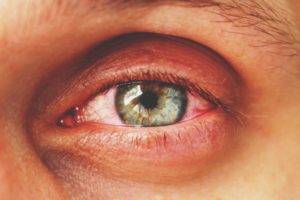Understanding Giant Papillary Conjunctivitis (A Guide)
Home / Eye Conditions & Eye Diseases /
Last Updated:
Table of Contents
The term giant papillary conjunctivitis is a long name for a few types of allergic reactions that affect the eyelids.
There are three types of GPC: two types of primary GPC and one secondary type, which is the most common form in the Western world.
Symptoms and causes of each type of GPC are very similar. A particle or foreign object, from pollen to a contact lens, is lodged in the eye, and the eyelid reacts.
It is important to stop wearing contact lenses immediately and get treatment from your eye doctor if you develop symptoms of GPC. Untreated forms can seriously damage vision.
What Is Giant Papillary Conjunctivitis?
Giant papillary conjunctivitis is a lengthy name for what is essentially an allergic reaction in the eye. It is a reaction to foreign objects, from pollen to contact lenses, that leads to an immunological response.

Unlike many forms of conjunctivitis, giant papillary conjunctivitis (GPC) is not contagious. It is not the same as pink eye, which is a bacterial or viral form of conjunctivitis.
Most people who develop this condition contract it because they wear their contact lenses too long — either several days in a row or past when they should be disposed of. In some instances, they develop it because contact lenses are not cleaned properly. Soft contacts are such a common cause of GPC that the condition is also often called contact lens-induced papillary conjunctivitis.
If the underside of the inner eyelid has papules, or several close-together raised bumps, and you also have itching and watering or discharge in and around the eye, you may have GPC. However, you need a diagnosis from a medical professional before beginning treatment for this condition.
Primary and Secondary Giant Papillary Conjunctivitis

If you contract giant papillary conjunctivitis, the most likely cause is soft contact lenses that have been worn for more than four weeks. The body has an immune response to this foreign body, and the inner eyelid becomes inflamed and irritated. However, GPC can also be part of the body’s allergic reaction to nylon or prosthetic materials.
There are two basic types of GPC. Both forms of GPC have many similarities, but they differ in their primary causes and the age of onset.
You deserve clear vision. We can help.
With 135+ locations and over 2.5 million procedures performed, our board-certified eye surgeons deliver results you can trust.
Your journey to better vision starts here.
- Vernal keratoconjunctivitis (VKC): This form mostly affects young men, between ages 6 and 12, who live in hot, dry climates like the Middle East, West Africa, and the Mediterranean Basin. It has also been found commonly in Japan, India, and South America. It is considered rare, but not unknown, in North America and Western Europe. VKC is an allergic reaction that is believed to occur when pollen or other grit gets into the eyes. While men are more affected than women, the gender gap decreases with age.
- Atopic keratoconjunctivitis (AKC): This form of GPC involves an immune system response alongside a chronic skin disease, like topical eczema or atopic dermatitis (AD). AD affects about 15 to 20 percent of children, and between 1 and 3 percent of adults, worldwide. Peak incidence occurs between 30 and 50 years old, typically involving both eyes at the same time. About 20 to 40 percent of people with AD develop AKC at some point in their lives.
There is also secondary GPC. This type of conjunctivitis is caused by something inside the eye irritating the eyelid, like a contact lens or suture.
What Causes Giant Papillary Conjunctivitis?
There are two main causes of GPC: seasonal allergies and contact lenses wear.
Primary GPC is caused by allergens. It occurs when immune cells hyperactively react to foreign substances in the body and promote collagen growth under the eyelids. Vernal keratoconjunctivitis is usually a result of seasonal allergies, while atopic keratoconjunctivitis is a complication that affects those with atopic eczema.
If you have primary GPC, chances are you have an allergy-related condition, such as asthma or eczema, or you might suffer from seasonal allergies.

Secondary GPC is caused by chronic irritation associated with prolonged wear of contact lenses or prostheses. All types of contact lenses can cause GPC, including soft lenses, rigid lenses and any type of hydrogel lenses.
If you wear contacts, you’ll first notice possible trouble when you close your eyes and feel as if there’s a foreign object inside your eye. The root of the problem is the edge of the contact lens that rubs against the eyelid. Considering you blink about 8,000 times a day, the constant rubbing can lead to inflammation and irritation.
Other possible causes of GPC include:
- Allergic reaction to contact lenses or the chemicals used to clean them
- Ocular prostheses, such as an artificial eye, rubbing against the eye
- Exposed sutures from an eye injury or procedure
- Deposits of proteins collecting on contact lenses
- Wearing contact lenses while having severe seasonal allergies or hay fever
Symptoms of Giant Capillary Conjunctivitis
GPC is characterized by large or “giant” papillae on the underside of the eyelid. If you notice any textural changes inside your eyelids, it could be the first sign of GPC.
Other symptoms of GPC include:
- Feeling like there’s something stuck in your eye
- Bumps that begin to form on the underside of your eyelid
- Itching or pain in the eyelid
- Redness of the eye
- Excess watering of the eye
- Swelling
- Blurry vision
- Discharge, mucus, or pus in the eye, especially coming from the lid
While early symptoms of GPC may not be as problematic, indications of severe GPC include:
- Intense itching
- Blurry vision
- Mucus developing quickly and in large amounts
- Movement of contact lens around your eye when you blink
- Bumps increase in number and size
The symptoms of advanced GPC are nearly intolerable and can lead to eye damage. They include:
- Clouding of contacts almost as soon as you wear them
- Deposits on your contact lenses
- Eyes sticking closed due to excess mucus production, especially upon waking up
- Intense pain
- More bumps on the underside of your eyelid
You deserve clear vision. We can help.
With 135+ locations and over 2.5 million procedures performed, our board-certified eye surgeons deliver results you can trust.
Your journey to better vision starts here.
Giant Papillary Conjunctivitis Treatments
The first step in treating GPC is to stop wearing contact lenses until the condition clears up. Dispose of the previous contact lenses, so you do not infect or inflame your eye again.
Other steps to take during GPC treatment include:
- Avoid wearing contact lenses for a few weeks or until the condition clears up. Wear glasses instead.
- If you must wear contact lenses, limit how long you do so.
- Use medicated eyedrops as prescribed by your eye doctor.
- If you receive a prescription for eye creams or ointments to use as treatment, only use them as prescribed.
- Change the type of contact lenses you wear. For example, switch from monthly wear to daily wear.
- Switch contact solutions. Try an unpreserved saline solution instead of one with many different chemicals and preservatives that may cause an allergic reaction.
If you frequently wear contact lenses to correct your vision, ensure that you follow all your doctor’s instructions on care and maintenance of the lenses and your eyes. Replace contacts as often as needed.
How Can You Prevent Giant Papillary Conjunctivitis?
If you’re prone to allergies, it’s advisable to reduce your exposure to the things that might trigger allergic reactions. For instance, start taking your allergy medications when high pollen counts are forecasted, keep indoor air clean and avoid tasks such as lawn mowing and weed pulling.

Also, start getting regular exams, especially if you have asthma, eczema, or seasonal allergies. An eye doctor will notice the symptoms, if any, and recommend measures to nip the condition in the bud.
To avoid GPC due to contact lens use, it’s imperative to practice proper lens care, including:
- Replacing contacts as often as needed
- Disposing the lenses in the advised time frame
- Switching out monthlies for dailies as there’s less risk for infection.
GPC can start at any time, even after safely wearing contact lenses for years. And therefore it’s imperative to consult an eye doctor if you notice any symptoms. But first, take out your contact lenses before scheduling a visit with your optometrist or ophthalmologist.
You deserve clear vision. We can help.
With 135+ locations and over 2.5 million procedures performed, our board-certified eye surgeons deliver results you can trust.
Your journey to better vision starts here.
References
- Eye Conjunctiva: Giant Papillary Conjunctivitis. (October 1, 2013). Pathology Outlines.
- Giant Papillary Conjunctivitis. (2009). The Free Dictionary: Medical Dictionary.
- Vernal Keratoconjunctivitis. (March 11, 2019). EyeWiki, American Academy of Ophthalmology (AAO).
- Atopic Keratoconjunctivitis. (November 27, 2018). EyeWiki, American Academy of Ophthalmology (AAO).
- Giant Papillary Conjunctivitis. (November 30, 2018). American Academy of Ophthalmology (AAO).
- Eye Conjunctiva: Giant Papillary Conjunctivitis. (December 24, 2020). Pathology Outlines.
- Giant Papillary Conjunctivitis. (May 18, 2021). American Academy of Ophthalmology.
This content is for informational purposes only. It may have been reviewed by a licensed physician, but is not intended to serve as a substitute for professional medical advice. Always consult your healthcare provider with any health concerns. For more, read our Privacy Policy and Editorial Policy.
